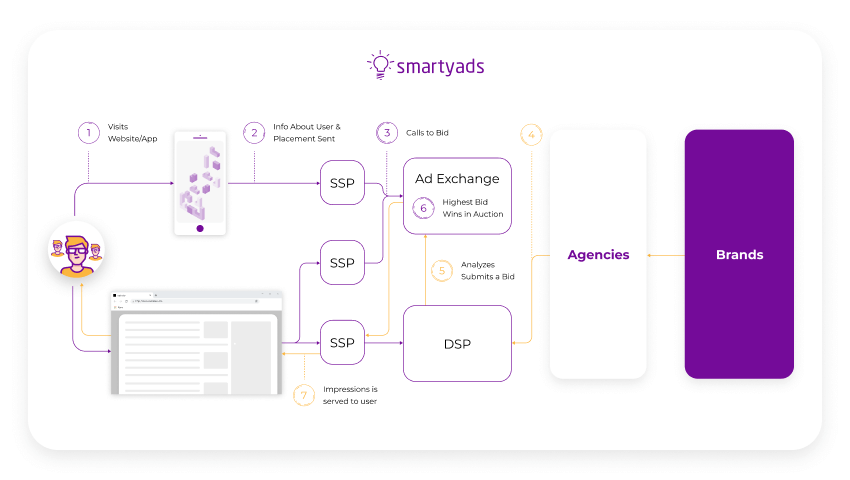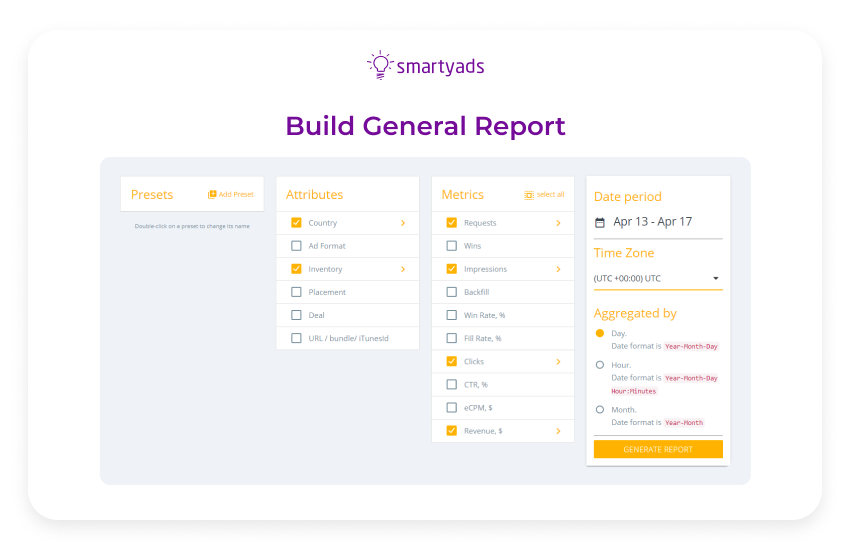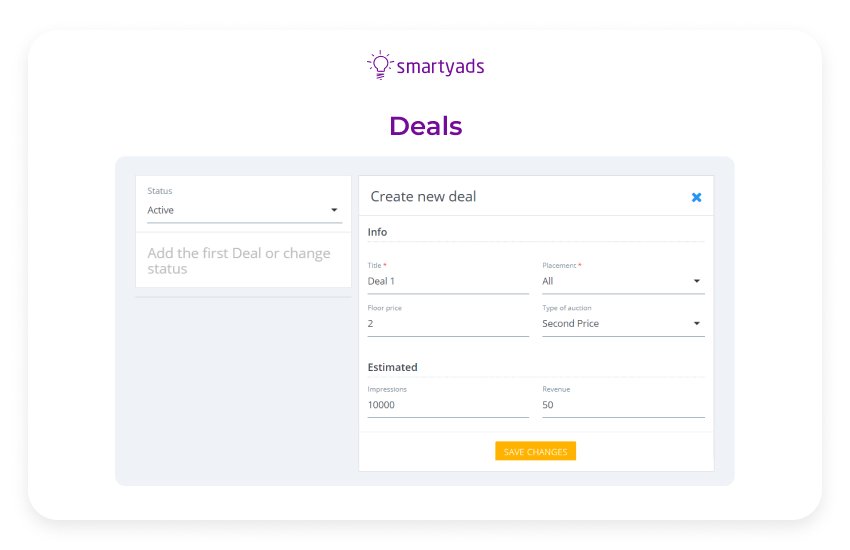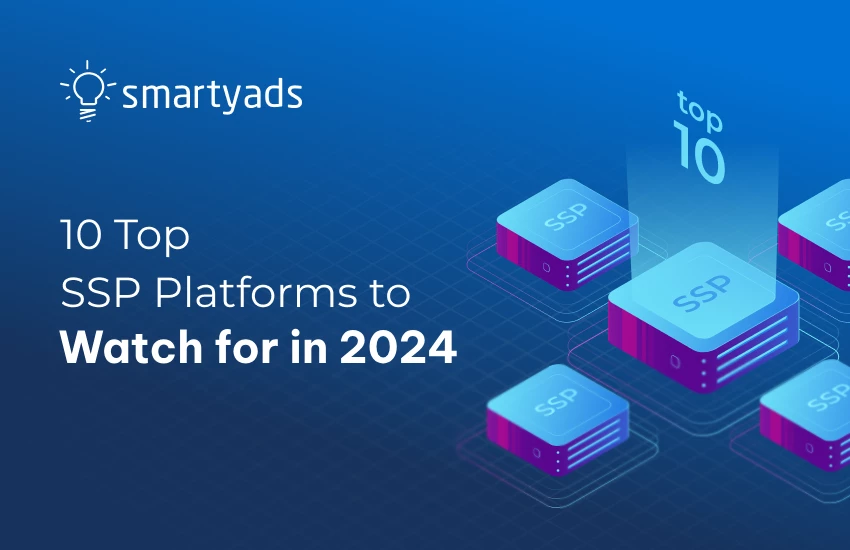Modern publishers search for the best SSP platforms to sell the ad inventory with minimum effort and the highest yield. However, it is not that easy to find out beforehand if top SSPs provide desired functionality and what exactly makes each one the best choice.
The right solution in such a case will be a supply-side platform that helps publishers maximize the value of their ad inventory while providing the best possible ways of maximizing ad revenue.
So, how do we choose the best supply-side platform (SSP) in 2025? We compiled the top 10 SSP platforms for publishers and app developers with cutting-edge features. Read, compare, and make your own conclusions, but first, let's review what SSP is and how SSP is integrated into the programmatic ecosystem.
Key Takeaways:
- Supply-side platforms connect publishers with multiple demand sources, enabling real-time bidding (RTB) and programmatic transactions to maximize yield with minimal manual effort.
- Top SSP features to look for — Strong analytics, diverse deal types (PMP, direct deals, open RTB), header bidding, broad demand partner access, ad quality controls, and advanced targeting capabilities.
- SSPs vs. other platforms — Unlike ad networks or ad exchanges, SSPs give publishers greater control over pricing, inventory segmentation, and monetization strategies.
- Key SSP platforms in 2025 — The market leaders include PubMatic, SmartyAds, Google Ad Manager, OpenX, Magnite, Xandr, SpotX, Teads TV, Index Exchange, Sovrn, each with unique strengths such as video-first monetization, premium demand access, or advanced AI optimization.
- Monetization best practices: Use detailed analytics, customize performance reports, set advanced parameters for ad placement, and leverage PMP auctions for premium inventory before open RTB.
- These strategies can be implemented and scaled effectively via SmartyAds SSP, which combines broad demand access, flexible deal structures, and AI-driven optimization to help publishers maximize revenue.

What are the features of the best SSPs, and how do they work?
SSP Supply-side platform is software that helps publishers to sell digital ad inventory to advertisers in a programmatic mode. The main task of an SSP is to meet publishers' requirements and needs and offer ad space with the biggest possible profit.
So, how do SSP platforms work? If shortly, this technology makes the process of media selling totally automated with smart ML and AI algorithms getting involved in plenty of tasks - from determining the price per impression to ad serving optimization.
In other words, such automatization is powered by real-time bidding RTB, the core task of which is to sell inventory to the highest bidder in the programmatic auction. The process is automated and implies a collaboration of the supply-side platform, demand-side platform, and ad exchange. The whole process may include trading desks and ad exchanges, but sometimes those platforms are not included (depending on the infrastructure).
First, web publishers and app developers define the parameters of future monetization: floor price for ad impressions (minimum cost), ad management (what ad sizes and formats to support), etc. Then, in real-time bidding auctions (that normally happen on ad exchange), the advertiser that offered the highest bid wins, and their ad impression gets served on the publisher’s inventory.

Read more about the programmatic ecosystem to find out the functions of each platform in detail - trading desks, buy side, and sell side platforms.
Why do publishers need SSP?
- It’s time-saving: thanks to supply-side platforms SSPs, there’s no need to look for demand partners and negotiate with them.
- It’s automated: with programmatic advertising, the process of media selling is fast and automatic.
- The best SSPs help publishers connect with lots of demand sources in real time and sell ad space with maximum revenue.
As programmatic digital display ad spending reaches new heights, more and more publishers strive to become a part of this vast ecosystem each year.
How are supply-side platforms (SSPs) different from other ad tech platforms then? Is there a difference between SSPs, ad exchanges, and ad networks?
Well, web publishers and app developers can sell their inventory on both platforms - SSP and ad exchange in real time. For example, Google has several ad platforms for monetization: Google Ad Manager, AdSense, ad exchange, and AdMob. Google Ad Manager is a very popular option these days. Ad exchanges and ad networks normally allow publishers to monetize their inventory with the same efficiency and automation as on SSP.
However, SSPs commonly have much greater publisher leverages and opportunities to fine-tune monetization as this platform is specifically designed for publishers (whereas ad exchange is an open marketplace for publishers and advertisers).
Ad networks, meanwhile, aggregate supply for further reselling to advertisers. Ad networks can function based on real-time programmatic bidding, or they can work on a non-programmatic basis.
Now, it’s time to review the top supply-side platforms and features that make them special on the market.
How to choose the best SSP for your needs
Choosing between SSPs is another challenge for web publishers. Let us reveal some points you need to consider while picking one of the sell-side platforms (SSPs).
Analytics
The SSP platform should provide the publisher with timely statistics regarding their inventory performance: how many ad impressions your inventory serves, how much revenue is getting generated (moreover, it should deliver the picture of the dynamics of ad revenue generation over time), etc.). Choose the best supply-side platform that works with real-time data. It is crucial to be sure that the statistics are up to date.
Demand partners
Pick an SSP that has its own ad server and one that constantly searches for new demand sources to provide you with the best deals without wasting time. The platform may be connected to RTB, which means that publishers can take part in the open auctions. Additionally, the SSP vendor may have direct connections with advertisers (in cases when the company also has a DSP in their infrastructure of solutions). Learn more about DSP vs SSP.
Different types of deals
Different deal types provide publishers with additional flexibility since they can choose how to sell their inventory. For example, direct deals and private marketplace auctions have their own perks since publishers have more control over their inventory, especially if it is exclusive inventory. At the same time, publishers can easily sell the rest of the ad slots in the open RTB real-time bidding auctions.

Top supply-side platforms for publishers
Finally, we’d like to mention 10 top SSPs that offer the best solutions for fruitful cooperation between publishers and demand partners and ads monetization in the digital advertising industry.
SmartyAds
SmartyAds is one of the best SSP platforms, but in fact, it is not just a supply-side platform. SmartyAds has built its own infrastructure of holistic programmatic solutions that includes a supply-side platform, a demand-side platform with proven demand partners, an ad exchange, and the WL platforms for enterprises. Leveraging flexible and easy-to-use SmartyAds SSP tools publishers and app developers can easily and effectively manage their inventory and gain yield by selling inventory at better prices.
Key features:
- Header bidding integration lets publishers reach more demand sources and boost inventory exposure;
- Multiple digital formats are available for the publisher to choose from (for any screen and environment - rich media, video, native, CTV, banner, and more). Ad quality is guaranteed by moderation;
- Innovative ML and AI technologies that increase demand and competition and let publishers reach top-tier advertisers;
- Convenient fill rates that help publishers to keep their ad revenue optimal;
- Comprehensive tools for the publishers to control and manage their ad campaign by different parameters (ad types and sizes, floor prices, filters, etc);
- Private marketplace deals and direct deals that allow publishers to sell their inventory to premium advertisers at the best price;
- Intuitive dashboard that enables publishers to easily manage inventory and analyze monetization performance;
- Anti-fraud protection and moderation for all ad content.
- Mobile SSP.
PubMatic
With access to 400+ demand-side platforms, ad exchanges, and ad networks, PubMatic expands publishers’ possibilities to maximize their income. PubMatic belongs to the top 10 supply-side platforms because it is trusted by thousands of reputable media owners worldwide, including Dictionary.com, Tribal Football, etc. Since their platform specifically focuses on publishers, it offers a very wide range of functionalities and publisher controls. It also features numerous media-selling variants for publishers - RTB deals, guaranteed and preferred deals, and PMP).
Key features:
- OpenWrap header-bidding with support on both sides, reporting, and various ad formats available;
- OpenBid SDK for higher demand allowing app developers to reach 200+ partners using header bidding, RTB, and private marketplace;
- Intuitive interface with analytical tools for insights generation and performance management in real-time;
- An access to a dashboard (analytics platform) with cloud-based UI so that publishers could get insights into aggregated data, and know how to manage the performance of demand they work with;
- Programmatic direct deals to sell top-class inventory at maximum CPM rates to trustworthy advertisers;
- Ad quality is guaranteed by moderation;
- Automated ad quality protection tools; the malware protection is ensured by The Media Trust and Confiant.
Google Ad Manager
This fully-fledged platform consists of a Google DFP ad server and Google AdX ad exchange. Based on eMarketer data, Google Ad Manager is the top SSP for publishers who can enjoy all ad sources in one place with support for multiple ad formats. Google ad manager is the first option that comes to mind because you can be sure of the quality of demand sources here. However, this advertising platform has its own specifics and best suits, big publishers, with large amounts of traffic (as the platform's description emphasizes). Alternative supply-side platforms SSPs are better suited to accommodate the needs of smaller publishers who have fewer visitors.
Key features:
- Strong analytics. Publishers can understand how digital advertising is performing since the platform generates robust publisher reports. The publisher can investigate revenue growth opportunities and find out general performance across campaigns;
- Advanced related tools. The publisher has access to different helpful tools like Data Studio, Google Analytics, BigQuery;
- Exchange Bidding for the publishers to partner with more advertisers and generate bigger income;
- A lot of deal types for publishers. The open auction, preferred deals, private auction, first look, RTB - Google offers a variety of options for publishers to sell the inventory;
- Video ads monetization in different ad formats, e.g. in-/out-stream and vertical across all devices;
- Publisher image protection measures and anti-fraud protection.
OpenX
The OpenX database is connected to 30 000 advertisers. It is one of the top 10 supply-side platforms that provides publishers with access to top demand partners. Such a platform helps publishers and app developers connect with first-class advertisers. It's not just a supply-side platform, but also an RTB exchange and ad server that allows publishers to boost revenue by getting maximum bids and leveraging agile programmatic solutions, private marketplaces, and direct deals. In order to start monetizing with OpenX, publishers should have around 10 million monthly page views.
Key features:
- A proprietary Demand Fusion technology delivers higher revenues and boosts competition;
- A lot of publishers control and fine-tune the monetization and ensure top-quality ad delivery.
- Robust analytics. Customizable reports get insights into campaign effectiveness.
- Ad exchanges connected to 30K advertisers;
- As a vendor, OpenX cooperates with the top publishers such as Venatus Media and VICE;
- Two header-bidding solutions: OpenX Bidder and Adapters for the publishers to sell ad inventory at the highest rate;
- The possibility to reach more than 45 DSPs and ad networks globally.
- Programmatic guaranteed, private actions, and preferred deals for more transparency, inventory control, and brand-safety issues mitigation.
Rubicon project (Magnite)
Magnite, formerly known as Rubicon project, is a well-known ad platform that at some point allied with Talariaand and changed its name in 2020. This solution also belongs to the top 10 SSP platforms on our list. Right now Rubicon project (Magnite) has an exclusive relationship with Hulu and Disney. It also works with other services such as Sling TV, Fubo TV, Philo, and Pluto TV. Magnite partners with broadcast channels including Fox and Discovery on its CTV apps. In order to join this monetization, the space publisher has to have 5M+ monthly page views.
Key features:
- Header-bidding wrappers of all convenient configurations, for example, Prebid;
- A plethora of programmatic deal types like PMPs, programmatic guaranteed, and preferred deals;
- Variety of ad formats that fit well into publisher’s ad space, both static and dynamic;
- Robust performance analysis on the level of the entire campaign and ad creative performance;
- Video monetization on innovative platforms like OTT, CTV, DOOH, etc;
- Data and traffic protection mechanisms;
- Privacy-friendly advertising standards (CCPA, GDPR adapted platform).
Xandr
Xandr, formerly known as AppNexus, collaborates with the most renowned publishers worldwide among which are Ouest France, Schibsted, and Seattle Times. Apart from the sell-side platform, the company has built several other ad tech solutions among which are Xandr ad exchange, Xandr Invest, and Xandr Curate. For monetization, Xandr puts a big emphasis on header-bidding opportunities as well as OTT and CTV advertising. Xandr states that publishers should have around 10M+ monthly page views in order to start monetizing.
Key features:
- Specialization and focus on audience-based TV advertising (OTT, CTV);
- Prebid header-bidding maximizes demand and thus yields from media trading. Prebid mobile is also available for mobile publishers who need to monetize AMP inventory. Prebid video is also available for monetizing through video ads;
- Ad quality is guaranteed since all ads are highly-targeted;
- Functionality makes it possible for publishers to forecast potential yield;
- Access to their ad server for superior yield optimization;
- Private marketplace exchanges are available to publishers with exclusive inventory so that they could magnify the value of their inventory while offering ad slots to the selected number of demand partners;
- Mobile application monetization. Agile tool kit allows getting benefits from showing digital advertising on mobile devices as well.
SpotX
SpotX positions itself as a selling solution that is focused on video advertising and a platform that provides the greatest leverages for video monetization. SpotX enables publishers to instantly connect to video demand in RTB and non-RTB deals so that they could maximize yield with ease.
Key features:
- Support for header-bidding unified auctions that maximize competition and publisher’s yield as a result. Both server-side and client-side options are available;
- Video player bidding. Opportunity to integrate with the most popular video players like JW Player, Brightcove, and more;
- Multiple ad format selection with a plethora of formats across video ads. Supported ad mediums include gaming consoles, connected TVs, or OTT devices;
- Flexibility in monetization: the opportunity to sell inventory in direct deals and RTB auctions alike;
- Since SpotX has integrated with major DMP providers (Adobe, Lotame, LiveRamp, and others), publishers have a chance to fetch additional in-deep insights into their audience data (the fee for DMP data enrichment is paid separately).
Teads TV
Teads TV is a platform that has been created for all kinds of video publishers across channels and mediums. That’s why it is often mentioned as the best supply-side platform in the video sector. The platform is very well focused on out-stream video monetization thanks to which publishers can gain enhanced yields from ad placement on their websites. Teads TV can be a really great choice for reputable publishers with a great number of monthly visitors, it is already trusted by CNN International, Mail Online, Bloomberg, BBC, and other well-known global media owners.
Key features:
- Extended video SSP leverages and opportunities since the platform is focused on video monetization;
- Access to data and creative lab. Publishers can access Teads Studio - a creative lab that also normally helps advertisers to build and personalize their ads across such environments as mobile, tablet, or desktop;
- Programmatic direct deals enable media owners to magnify the value of their inventory while offering it to a selected number of advertisers. After this, if inventory is still unsold, the publisher can offer it in the open RTB auctions;
- Native ads. Publishers can find a great selection of native ads that they can serve. These ads won’t interfere with user experience but will ensure seamless monetization;
- In the dashboard of the platform, publishers can analyze how their inventory is performing. Also, they can discover performance across various demand partners they trade with.
Index Exchange
Index Exchange is actually an SSP platform that works programmatically and helps publishers to monetize their inventory with the best CPM rates as they claim on their website. They also have a solution for CTV publishers that enables seamless monetization with video ads. Apart from CTV, they offer monetization through display, video, mobile, and native ads. The abundance of monetization options makes them one of the best supply-side platforms.
Key features:
- Support for header bidding most commonly used wrappers. As a Prebid community member, Index Exchange can also assist publishers with Prebid server adapter integration. The header bidding wrappers are also adapted to GDPR TCF1 and TCF2 requirements;
- Trading is enabled across the RTB environment, direct sales, and PMP which maximizes the opportunities for publishers;
- Elevated CPM rates are achieved thanks to premium demand, addressability, and enhanced data intelligence;
- Total transparency. Publishers can analyze their inventory performance on the impression level to make smarter monetization moves. The reports can be generated in real-time;
- Optimization. The team also assists publishers with optimizing bid requests and configuring inventory so that it brings higher revenues.
Sovrn
Sovrn is a platform for publishers that integrates media-sellers with advertisers all around the world (thanks to the programmatic algorithms). This way publishers can easily reach reputable demand partners and monetize their mobile apps and other types of inventory. What’s peculiar about Sovrn is that it also helps sellers to benefit from Google’s Exchange Bidding Dynamic Allocation, Amazon’ TAM (Transparent Ad Marketplace).
Key features:
- Server-side header bidding is enabled by a powerful wrapper that eliminates latency and makes unified auctions streamlined;
- Easy-to-review performance. It’s easy to analyze monetization performance with data management, bid level reporting, and domain filtering available on the platform;
- Advanced analytics. With available tools, publishers can analyze the behavior of bid requests, fetch the performance data and data regarding ad providers;
- Access to proprietary Ad Block Unblock tool that explains to the publisher the impact of ad blocking on their monetization;
- Available direct deals for yield maximization;
- Additional opportunities to monetize in-app data, location data, and more.
Tips for successful monetization on SSP
Top SSPs may help you to monetize inventory with ease and efficiency, however, you can also follow the best practices of inventory monetization on SSP in order to achieve greater results.
- Create performance reports according to custom metrics. Every SSP platform has analytics, however, publishers may overlook an opportunity to adjust reports up to their needs. For example, on SmartyAds SSP publishers can select attributes – qualitative indicators by which traffic can be categorized: its country, inventory or placement, etc. They can also choose metrics – quantitative indicators of traffic: quantity of requests, wins, impressions, or rates, such as fill-rate, win rate, or click-through-rate. Choose what you want to analyze and select a suitable period. Alternatively, as a publisher on SmartyAds SSP, you can use presets to generate required reports much faster.

- Set advanced parameters. If you have specific requirements, for example, you want the ads to appear in a certain way on your inventory, then use advanced settings on SSP. For instance, on SmartyAds, SSP publishers can choose a playback method for video ads, video linearity, and other details that will define the user experience. Additionally, publishers can choose blocked placement attributes so that ads can be blocked by specific attributes and more.
- Sell exclusive inventory in PMP auctions. In private auctions, publishers normally sell the inventory to the selected advertisers, that’s why the majority of media sellers prefer to offer rare ad slots at PMP auctions before they tap into open RTB auctions. The publisher’s SSP should be connected to the advertiser's DSP in order to take part in PMPs. The good news is, that SmartyAds SSP and SmartyAds DSP are already connected to each other, so publishers don't need to bother about organizing such a connection.

Conclusion
Now you know more about the top SSP platforms and can use all their advantages to increase yields by offering your inventory to multiple ad buyers at the highest rates. SSP will help you reach more advertisers across the ecosystem of programmatic advertising, including ad networks, ad exchanges, and demand-side platforms. This will save you time and money. Choose one of the solutions that best fit your requirements and take your digital advertising experience to a new level!
Want to instantly reach the premium demand partners across the globe? Get registered at SmartyAds SSP!
FAQ
Selecting the right SSP depends on factors like your audience size, traffic sources, ad formats supported, and integration capabilities. It's essential to consider platforms that align with your specific needs and goals.
Yes, many publishers use multiple SSPs to maximize their revenue potential. This approach allows access to a broader range of demand sources and can help fill unsold inventory more effectively.
While many SSPs are free to use, some may charge fees based on revenue share or other models. It's crucial to understand the fee structure and any potential hidden costs before integrating an SSP.
Platforms like SmartyAds SSP offer seamless integration with top demand partners, enabling publishers to manage and optimize their ad inventory across various channels with maximized yield.





